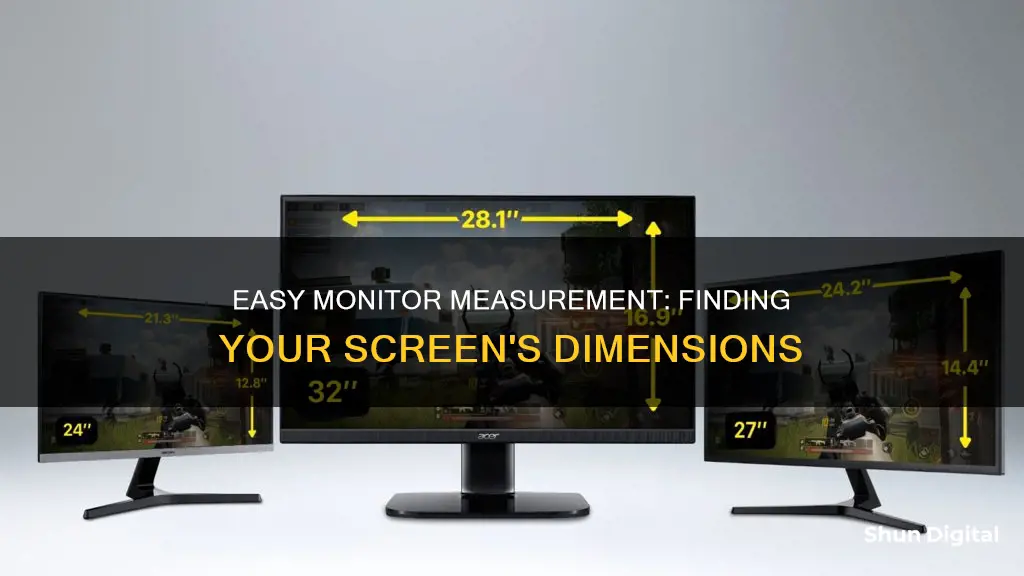
There are several ways to find the dimensions of your monitor. The most common method is to physically measure the screen with a measuring tape or ruler. To do this, start at the top-left corner of the screen and pull the tape diagonally to the bottom-right corner. Make sure to only measure the screen itself and not the bezel or frame around it. The resulting measurement, typically given in inches, is the standard size of your monitor. Alternatively, you can find the monitor's model number, which often includes the screen size, or review the specifications of your device, which should include the screen size under a section labelled Screen, Display, or something similar.
| Characteristics | Values |
|---|---|
| How to find your monitor's dimensions | Use a ruler or measuring tape to measure the diagonal distance from one corner of the screen to the opposite corner. Do not include the bezel or frame in your measurement. |
| Aspect ratio | The aspect ratio is the relationship between the height and width of a rectangular display. Common aspect ratios for computer monitors are 4:3, 5:3, 16:9, or 16:10. |
| Diagonal screen size formula | Diagonal screen size = √(height2 + width2) |
| Units | Inches or centimetres |
What You'll Learn
- Diagonal measurement: Measure the distance from one corner of the screen to the diagonally opposite corner
- Aspect ratio: Compare the length and height of the screen
- Pythagorean theorem: Use this theorem to calculate the diagonal distance
- Monitor model number: The size is often included in the model number
- Check specifications: Review the laptop or smartphone specifications for the screen size

Diagonal measurement: Measure the distance from one corner of the screen to the diagonally opposite corner
To find the diagonal measurement of your monitor, you will need a tape measure or a ruler.
Place the tape measure or ruler at one corner of the screen's viewable area. Extend it to the diagonally opposite corner of the screen. Make sure to only measure the screen itself, not the bezel or frame around the screen.
Once you have the diagonal measurement, you can round it up or down to the nearest inch. This is the size of your monitor screen. For example, if the diagonal distance is 23.5 inches, you can say your monitor screen is 24 inches.
You can also use the Pythagorean theorem to determine the distance of the diagonal. Square the screen's height and width, add the two numbers together, then find the square root of the sum. This will give you the diagonal measurement.
Connecting Xbox 360 to an HDMI Monitor: A Step-by-Step Guide
You may want to see also

Aspect ratio: Compare the length and height of the screen
The aspect ratio of a monitor is the proportional relationship between the physical width and height of the display. It is usually written as two numbers separated by a colon (x:y), where x represents the width and y the height. For example, a common aspect ratio for monitors is 16:9. This means that for every 16 units of width, there are 9 units of height.
To compare the length and height of your screen to find the aspect ratio, you can use a simple formula:
AR = width / height, where AR is the aspect ratio.
For example, if your screen has a width of 16 inches and a height of 10 inches, your aspect ratio would be 16/10, or simplified, 16:10.
- 4:3 aspect ratio: For every 4 units of width, there are 3 units of height.
- 16:10 aspect ratio: For every 16 units of width, there are 10 units of height.
- 1.85:1 aspect ratio: This is often referred to as "widescreen" and is wider than the standard 16:9 ratio, allowing for a broader horizontal frame.
- 2.39:1 aspect ratio: Also known as "anamorphic widescreen," this ratio is even wider than 1.85:1 and is commonly used in cinema.
It's important to note that while aspect ratios are typically written as two numbers separated by a colon, they can also be written as N:1, where N = W/H. For example, a 16:9 aspect ratio can also be written as 1.78:1 (16/9:1).
Additionally, when measuring the size of your monitor, it is standard to refer to the diagonal measurement, which can be calculated using the Pythagorean theorem:
Diagonal screen size = √(height^2 + width^2)
So, if you have a monitor with a resolution of 1920 x 1080 and an aspect ratio of 16:9, you can calculate the diagonal screen size as follows:
Diagonal screen size = √(1080^2 + 1920^2) / 96 = 21.5 inches
Monitoring Web Usage: Strategies for Tracking Online Activity
You may want to see also

Pythagorean theorem: Use this theorem to calculate the diagonal distance
To find the diagonal distance of a monitor, you can use the Pythagorean theorem. This method is particularly useful if the monitor is too large to measure directly or if you don't want to risk smudging the screen.
The Pythagorean theorem is a formula that can be used to find the length of the hypotenuse of a right-angled triangle:
`a^2 + b^2 = c^2`
Where `a` and `b` are the side lengths of a right triangle, and `c` is the length of the hypotenuse.
In the context of finding the diagonal distance of a monitor, the length and width of the monitor are the side lengths of the triangle, and the diagonal distance is the hypotenuse.
- Measure the length and width of the monitor screen in inches. Ensure that you only measure the viewing screen and not the frame or bezel around it.
- Square the length and width measurements. For example, if the length is 16 inches, square it to get 256.
- Add the squared length and width. Continuing the example, 256 (squared length) + 100 (squared width) = 356.
- Calculate the square root of the sum. The square root of 356 is approximately 18.9, which is the diagonal distance of the monitor.
You can also use an online calculator or a calculator application on your device to perform the calculations.
Additionally, if you're using a Windows or Mac computer, you can find the diagonal measurement of your monitor by checking the display settings on your system.
Connecting LG Monitor to MacBook Air: A Simple Guide
You may want to see also

Monitor model number: The size is often included in the model number
If you're struggling to find the size of your monitor, the model number is a good place to start. The size of a monitor is often included in the model number. For example, an Acer 20-inch screen could have a model number of S201HL. The "20" after the "S" here indicates the size of the monitor. Typically, a monitor model number starts with one or two letters, followed by numbers. The first two numbers after the letters usually represent the size of the monitor.
If you're unsure where to find your monitor's model number, it's usually printed along the top or bottom edge of the monitor, or on a sticker on the back of the monitor. You can also find the model number by checking the monitor's settings. On a Windows 10 operating system, go to Settings > System > Display, then scroll down and click on Advanced Display Settings. This will bring up a list of details about your monitor, including the model number.
If you're still unsure, you can always measure the screen size of your monitor. Using a measuring tape, start at the top-left corner and pull diagonally to the bottom-right corner. Just be sure to only measure the screen itself and not the bezel (the plastic edge) around it.
Monitoring Java Memory Usage: A Comprehensive Guide
You may want to see also

Check specifications: Review the laptop or smartphone specifications for the screen size
If you want to know the screen size of your laptop or smartphone without measuring it, you can check its specifications. For laptops, the specifications will include details about the screen size, usually listed in inches. Check the laptop's specifications for a section labelled "Screen", "Display", or something similar. The screen size will be listed there. If you can't find it, you can search for your laptop model online, which should provide the screen size.
For smartphones, the process is similar. Check the specifications for a section labelled "Screen", "Display", or something similar. The screen size will be listed in inches. If you can't find it, searching for your smartphone model online will provide the screen size.
In addition to checking specifications, some sources suggest that for laptops, the model number can provide a clue about the screen size. For example, an Acer 20-inch screen model might have a number like S201HL, where the "20" after the "S" indicates a 20-inch screen. However, this method may not always be reliable, and it's best to check the specifications or the model online to be sure.
It's worth noting that the standard way to measure monitor size is by measuring the diagonal length of the screen, from the top-left corner to the bottom-right corner, excluding the bezel or frame. This can be done physically with a measuring tape or ruler, or by using online tools that detect the number of pixels to determine the screen size.
Utilizing AMD GPU Potential: Dual Monitor Setup Guide
You may want to see also
Frequently asked questions
The dimensions of your monitor are the length and width of the screen. To find these, measure the distance from the top-left corner of your screen to the bottom-right corner. Do not include the bezel or frame in your measurement.
The diagonal measurement is the standard way to describe the size of your monitor. To find this, measure the distance from one corner of the screen to the diagonally opposite corner. Again, do not include the bezel or frame in your measurement.
The aspect ratio is the relationship between the height and width of your monitor. Common aspect ratios include 4:3, 5:3, 16:9, and 16:10. You can find the aspect ratio by comparing the length and height of your monitor.
If you don't have access to a ruler or tape measure, you can use the Pythagorean theorem to calculate the diagonal measurement of your monitor. First, square the height and width of your monitor, then add the two numbers together, and finally, find the square root of the sum.







